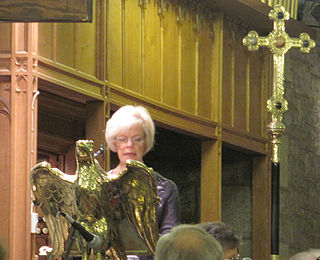Origins
Originating in early-fifteenth century in Europe as spoons used at table (often produced in sets of thirteen, the thirteenth, showing Jesus, usually being referred to as the 'Saviour' or 'Master' spoon). The British Museum in London has a set from England dating from 1536–7 which has a figure of the Virgin Mary on the thirteenth spoon. [3] By the sixteenth century they had become popular as baptismal presents for godchildren, but were dying out by the 1660s. In some communities this tradition continued until at least the mid-twentieth century.
They first appeared as a bequest in the will of one Amy Brent who, in 1516, bequeathed "XIII sylver spones of J' hu and the XII Apostells." They are alluded to by the dramatists Ben Jonson, Thomas Middleton, Francis Beaumont, and John Fletcher. Shakespeare refers to it in Henry VIII, Act 5, Scene 3, where Cranmer declines to be sponsor for the infant Elizabeth because of his lack of money. King Henry banters him with "Come, come, my lord, you'ld spare your spoons."
Sets of the twelve apostles are not common, and complete sets of thirteen, with the figure of Jesus on a larger spoon, are still rarer. [6]
The spoon shown opposite is typical of single spoons not part of a set. In this case the apostle is simply holding what appears to be a book. Such examples would typically be in electroplated nickel silver and marked on the rear face with "EPNS."

Barnabas, born Joseph (Ἰωσήφ) or Joses (Ἰωσής), was according to tradition an early Christian, one of the prominent Christian disciples in Jerusalem. According to Acts 4:36, Barnabas was a Cypriot Jew. Named an apostle in Acts 14:14, he and Paul the Apostle undertook missionary journeys together and defended Gentile converts against the Judaizers. They traveled together making more converts, and participated in the Council of Jerusalem. Barnabas and Paul successfully evangelized among the "God-fearing" Gentiles who attended synagogues in various Hellenized cities of Anatolia.

Simony is the act of selling church offices and roles or sacred things. It is named after Simon Magus, who is described in the Acts of the Apostles as having offered two disciples of Jesus payment in exchange for their empowering him to impart the power of the Holy Spirit to anyone on whom he would place his hands. The term extends to other forms of trafficking for money in "spiritual things".

A spoon is a utensil consisting of a shallow bowl, oval or round, at the end of a handle. A type of cutlery, especially as part of a place setting, it is used primarily for transferring food to the mouth. Spoons are also used in food preparation to measure, mix, stir and toss ingredients and for serving food. Present day spoons are made from metal, wood, porcelain or plastic. There are a wide variety of spoons that are made of a variety of materials and by different cultures for many different uses and foods.

The Encyclopædia Britannica Eleventh Edition (1910–1911) is a 29-volume reference work, an edition of the Encyclopædia Britannica. It was developed during the encyclopaedia's transition from a British to an American publication. Some of its articles were written by the best-known scholars of the time. This edition of the encyclopaedia, containing 40,000 entries, has entered the public domain and is easily available on the Internet. Its use in modern scholarship and as a reliable source has been deemed problematic due to the outdated nature of some of its content. Modern scholars have deemed some articles as cultural artifacts of the 19th and early 20th centuries.

The Kingdom of France was organised into provinces until the National Constituent Assembly adopted a more uniform division into departments (départements) and districts in late 1789. The provinces continued to exist administratively until 21 September 1791.

Pascual de Gayangos y Arce was a Spanish scholar and orientalist.

Peter Buchan was a Scottish editor, publisher, and collector of ballads and folktales.

In Christian tradition, the Four Evangelists are Matthew, Mark, Luke, and John, the authors attributed with the creation of the four canonical Gospel accounts. In the New Testament, they bear the following titles: the Gospel of Matthew; the Gospel of Mark; the Gospel of Luke; and the Gospel of John. These names were assigned to the works by the early church fathers in the 2nd century AD; none of the writers signed their work.

Harry Bates was a British sculptor. He was elected to the Royal Academy in 1892 as A.R.A. and was an active, if intermittent, member of the Art Workers Guild. He was a central figure in the British movement known as New Sculpture.

Roncesvalles is a small village and municipality in Navarre, northern Spain. It is situated on the small river Urrobi at an altitude of some 900 metres (3,000 ft) in the Pyrenees, about 4 kilometres (2.5 mi) from the French border as the crow flies, or 21 kilometres (13 mi) by road.

Francisco Salzillo y Alcaraz was a Spanish sculptor. He is the most representative Spanish image-maker of the 18th century and one of greatest of the Baroque. Francisco Salzillo worked exclusively on religious themes, and almost always in polychromed wood. He made hundreds of pieces that are distributed throughout the Region of Murcia and some in bordering provinces. The Spanish Civil War (1936–1939) caused the destruction of many of the works of Salzillo. Some of his masterpieces include his nonprocessional religious work, his processional work, and his great Nativity scene.

Charles Haslewood Shannon was an English artist best known for his portraits. These appear in several major European collections, including London's National Portrait Gallery. Several authorities spell his middle name Hazelwood. The National Portrait Gallery prefers the spelling used here.

A tea caddy is a box, jar, canister, or other receptacle used to store tea. When first introduced to Europe from Asia, tea was extremely expensive, and kept under lock and key. The containers used were often expensive and decorative, to fit in with the rest of a drawing-room or other reception room. Hot water was carried up from the kitchen, and the tea made by the mistress of the house, or under her supervision.

Filigree is a form of intricate metalwork used in jewellery and other small forms of metalwork.
Arator was a sixth-century Christian poet from Liguria in northwestern Italy. His best known work, De Actibus Apostolorum, is a verse history of the Apostles.

A lection, also called the lesson, is a reading from scripture in liturgy. In many Christian denominations, the readings of the day are appointed in the lectionary.
Xenien is a Germanization of the Greek Xenia "host gifts", a title originally applied by the Roman poet Martial to a collection of poems which were to accompany his presents.
Henry Copeland, aka Henry Copland, was an 18th-century English cabinetmaker and furniture designer. In partnership with Mathias Locke during the mid-18th century in London, they produced many furniture designs in the Rococo Furniture Style. However both men worked for Thomas Chippendale the elder and many of their designs appear, without acknowledgement, in his book of designs, The Gentleman and Cabinet Makers Director, published two years later. However a study of the original drawings suggests that they may have actively collaborated with Chippendale on his book.
A bumbulum, or bombulum, was a musical instrument described in an apocryphal letter of St. Jerome to Caius Posthumus Dardanus, and illustrated in a series of illuminated manuscripts of the 10th to the 11th century, together with other instruments described in the same letter. These are the Psalter of Emmeran, 10th century, described by Martin Gerbert, who gives a few illustrations from it; the Cotton manuscript of Tiberius C. VI in the British Museum, 11th century; the famous Boulogne Psalter, A.D. 1000; and the Psalter of Angers, 9th century.

Saint-Servan is a town of western France, in Brittany, situated 2 miles from the ferry port of Saint-Malo. It is renowned for its shops and restaurants.


















